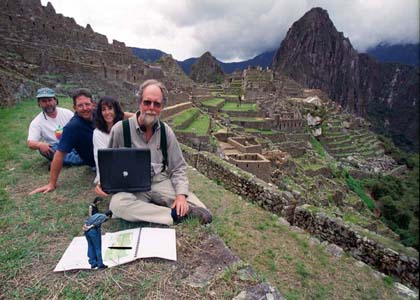Museum vistors To Explor Machu Picchu Using 21st Centry Technology
by
Nancy Ackley*
*A hypertext adaptation of the original article that appeared in Cal State's Faculty/Staff Newsletter, theView, January 17, 2000.
When Yale University's natural history museum opens its Machu Picchu exhibit next year, visitors will explore the ruins of the 15th century city using 21st century technology provided by California State University, East Bay.
The archaeological exhibition at Yale's Peabody Museum of Natural History will include a virtual reality tour of the entire city of Machu Picchu and adjacent Inca Trail. The tour is the work of Cal State East Bay archaeology professor George Miller, a team of CSUEB Media Center staff and graduate students.
Elements of the exhibit will be displayed in the future in the C.E. Smith Museum of Anthropology at Cal State East Bay, according to Miller.
"Whatever form our Cal State East Bay exhibition takes, it's a guarantee that the visitor will have the chance to take a virtual tour of one of the world's most mysterious and majestic ancient sites," Miller said.
Miller and Terry Smith, photographer and coordinator of the New Media Servicesduendes laboratory at Cal State East Bay, traveled to Peru most recently in October to take 360-degree digital photographs of the city's terraced mountainside, granite walls and steps, caves and an occasional llama.
Others working on the project were Michael Bortner, a CSU master's degree candidate, and three recent Yale anthropology graduates, Nick Kouchoukos, an assistant professor at the University of Chicago, Regan Huff,an exhibit designer at the Mac Wane Center in Birmingham, Alabama, and Ana Maria Pavez, an archaeologist from Chile.
The ruins of Machu Picchu were discovered in 1911 by Hiram Bingham, a Yale University professor (1907-25) and Connecticut's governor (1925) and U.S. Senator (1925-33). The Peabody Museum is preparing an exhibit about Bingham's discovery of the Incan city to coincide with the university's 300th anniversary.
Miller first learned of the upcoming Machu Picchu exhibit in 1994 when he was a visiting professor at Yale, teaching archaeology courses and conducting research on the animal bones found in the Machu Picchu tombs.
He approached his Yale colleague Richard Burger, who is director of the Peabody and a former CSUEB lecturer (1979). Miller suggested the display could be enhanced by a computerized component that would educate museum visitors about specific features of Machu Picchu and allow them "to explore and discover the natural, maze-like structure of the site" using panoramic virtual reality photography.
Miller's proposed augmenting the static displays in cases and on the museum walls with computer stations that would provide multiple, navigable, 360-degree views of the pre-Columbian city.
On their last trip to the city Miller and his teammates took more than 250 panoramic images, using two Olympus digital cameras with wide-angle lenses and special virtual reality equipment. During a previous trip to Machu Picchu in 1996 Miller shot 40 panoramas using traditional film photography.
"Shooting digitally allowed us to download the images a couple of times a day to the two laptops we had with us, review the images, and reshoot where needed," Miller said. "We set up a kind of field laboratory in the Machu Picchu Hotel bar. It was a great way to do archaeology!"
Since their return from Peru, Miller and Smith have been working in the CSUEB New Media Services laboratory, electronically "stitching together" more than 5000 separate images to create the panoramas. The CSUEB/Yale team plans to return once more to estimates that an additional 200 panoramas of Machu Picchu and its surroundings will be necessary to complete the project.
Eventually they will add virtual reality images of some 100 artifacts they photographed at the Peabody Museum in 1997 and the ambient sounds they recorded at Machu Picchu in October. The recordings include such sounds as the flow of water through the 16 ceremonial fountains, the roar of the Urubamba River 2,000 feet below the city ruins, the Quechua (Inca) language being spoken, and footsteps on the 3,000 steps that line the five-square- mile site.
Yale and Cal State East Bay have collaborated on the digital project, with Hayward providing the technology component, Miller said.
"It was an honor to teach at Yale, but equally thrilling has been the opportunity to share with them the technological strength that Cal State East Bay, with its Media and Technology lab and multimedia master'sprogram, is uniquely positioned to provide."
Another facet of Miller's digital work is attracting notice at Yale. During his second visiting professorship in 1997, he and students scanned nearly 1,000 black and white photographs of Machu Picchu that Bingham took in 1911, 1912 and 1915.
"Bingham was quite a good photographer for that era," Miller said,"and he often took multiple shots from a single point allowing him to physically paste together panoramas."
By using Apple Computer Quicktime™ Virtual Reality technology to reprocess Bingham's original photographs, Miller has created a virtual time machine and made it possible to view some of Bingham's old static photos in a dynamic, navigable form, to focus in on small details and to enlarge them for closer inspection.
The initial, major Machu Picchu exhibition will be in Yale's Peabody Museum and four other venues around the country, with a special virtual version appearing at Cal State East Bay's C. E. Smith Museum of Anthropology, where Miller is the museum director.
Miller is hoping that he and Amy Rodman, a member of the Cal State East Bay art faculty and Andean scholar, will collaborate on an exhibit entitled "The Incas and Their Ancestors," for the C.E. Smith Museum in fall 2001 or winter 2002.
All contents copyrighted © 2000 by Nancy Ackley, CSUEB, George R. Miller, CSUEB and the Peabody Museum of Natural History, Yale University.





